ASUS OLED PG42UQ V40 Firmware Best HDR & SDR Settings Guide

Last updated on June 19, 2025
The new ASUS Rog Swift PG42UQ OLED firmware is out, V40 (aka Version 40). So far, I think this is the best iteration of the firmware.
Table of Contents
PG42UQ V040 HDR Performance Results
I haven’t had any weird black screens like a lot of us were experiencing with V037. Color reproduction in HDR is much better than V037 & V033, but it isn’t perfect. Colors are deeper and richer than before but still require an increase in vibrance. I do feel the brightness has gone down a little bit, but it isn’t that noticeable.
Color Tones are Still Off
My first problem with V40 (and with previous firmware versions), are the surplus of red tones/lack of blue tones. Whites look too beige due to too much red tones being present. I am not sure why ASUS likes the warm tone so much, to me it doesn’t look good. Looks even worse if you are wearing protective blue-light eye gear…
Color Saturation Better but, Still Needs Adjustment
Second, color saturation is still low. Don’t get me wrong, it is much better than any other PG42UQ firmware version, but it still misses the mark and, could use an increase of roughly 21%. I can’t help but wonder how the color adjustment process works when ASUS is creating drivers.
Guide to Improve PG42UQ HDR Setting
Fortunately, there is a workaround for the two issues above. While we all wish we didn’t have to make adjustments to our PG42UQs, it is an acceptable trade-off to have to not switch between SDR and HDR modes. This is especially true if you are using NVIDIA Surround, since color space & refresh rates can be affected when switching between HDR and SDR.
Looking for Your Help & Support
If you have any questions, feel free to reach out via WiredColony. Also, for notifications and updates for this guide, you can add your name to our email to the list. Without further ado, Let’s get started!
Receive notifications for updates to this guide and PC monitor related content. By adding your email to our list, you are:
- Helping us keep this guide updated
- Supporting the creation new guides in the future
- Helping us obtain and test new products from manufacturers.
- We DO NOT SHARE your email with any 3rd parties.
We thank you for showing your support for the PG42UQ HDR Settings Guide and our site!
Best PG42UQ HDR & SDR Settings Firmware V40
If you want to get the best colors out of your PG42UQ, I suggest you follow the guide below. It will correct the beige-whites and enhance color saturation issues. Before adjusting colors, you need to make sure all other settings are configured correctly, and drivers/apps/firmware are installed. If you have completed some of the steps below, you can skip them, but I highly recommend you complete them in the order (With exception to Installing the Display Driver.).
Step 1: Update Your PG42UQ to Firmware V40
- Download PG42UQ Firmware V40 here (USA Site)
- Follow the instructions on how to install the PG42UQ firmware here. (Skip “step 3” on the linked page, since you already downloaded V40). For the rest of the guide on the linked page, replace “V033” with “V40”. After you complete the firmware update, come back to this guide and move onto the next step.
- **IMPORTANT** Be sure to precisely follow the firmware update instructions. Mistakes here could result in the firmware installing incorrectly and is attributed to “false positive” installations and poor monitor operation.
Install PG42UQ Display Driver for Windows 10/11
Step 2: Download and Install PG42UQ Display Driver
- Go to the following link for directions on how to download and install the display drivers in Windows for your ASUS OLED PG42UQ. The picture below is an example of what the settings look like. After you complete the display driver installation, come back to this guide and move onto the next step.
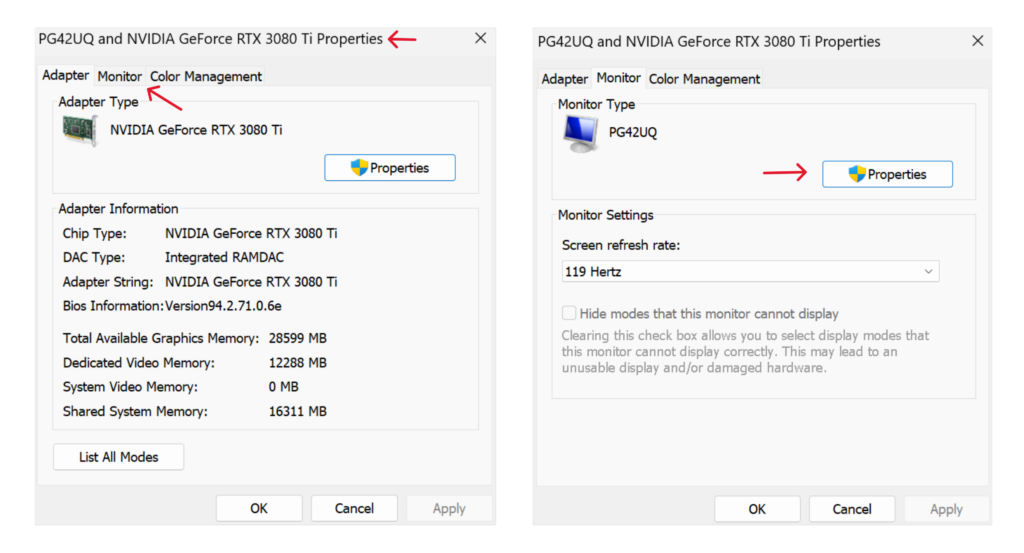
Adjust Windows Display Settings HDR for SDR Content
Step 3: Windows Display Settings HDR-SDR Content Brightness
- Follow this guide here to adjust the brightness of SDR content when in HDR mode. After completing the HDR-SDR Content Brightness, come back to this guide and move on to Step 4. (See picture below for example)
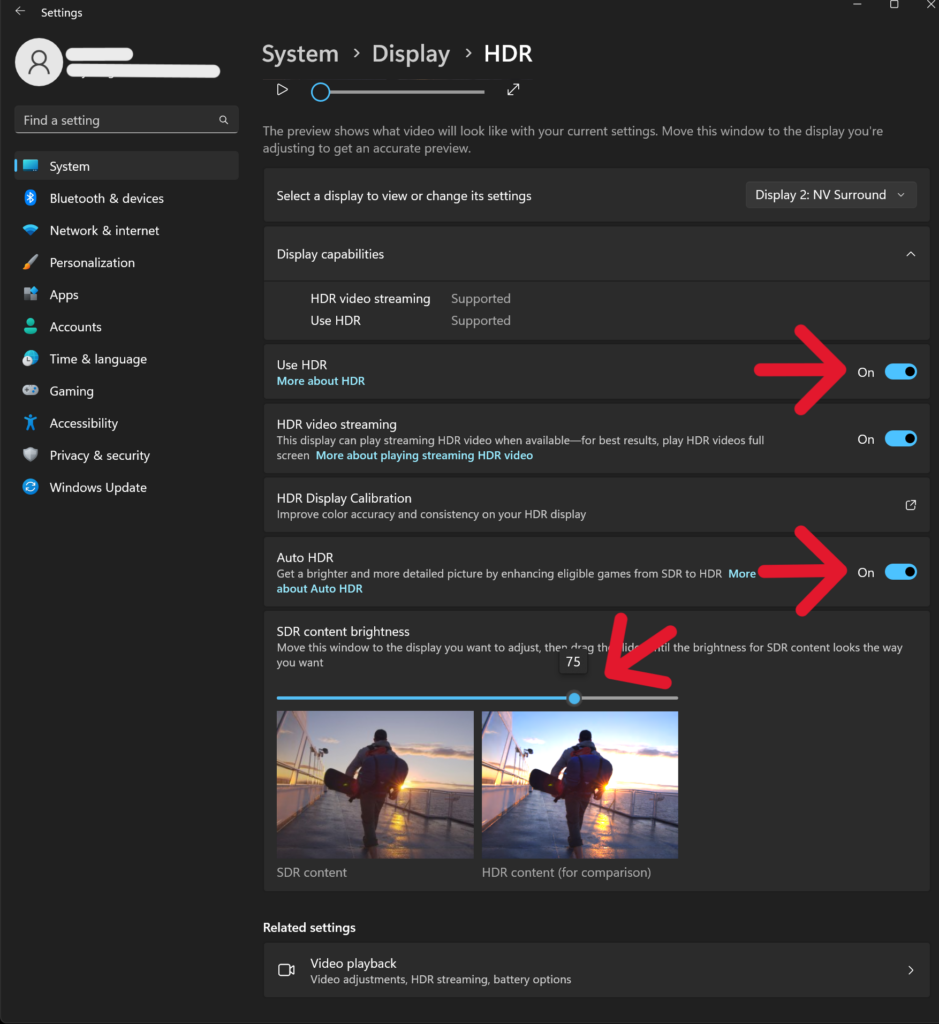
Download and Install Windows 11 HDR Calibration App
Step 4: Install Windows HDR Calibration App
- Download and Install Windows HDR Calibration APP
- Start Menu-> Search: Microsoft Store
- Microsoft Store Window->Search->Windows HDR Calibration App->Get
- Run Windows HDR Calibration App (**Note** The HDR settings on the PG42UQ Monitor for this guide is set to “ASUS Gaming HDR”)
- Before you run the app, make sure HDR is turned on in Display settings->HDR.
- Run Windows HDR Calibration app and follow the app instructions.
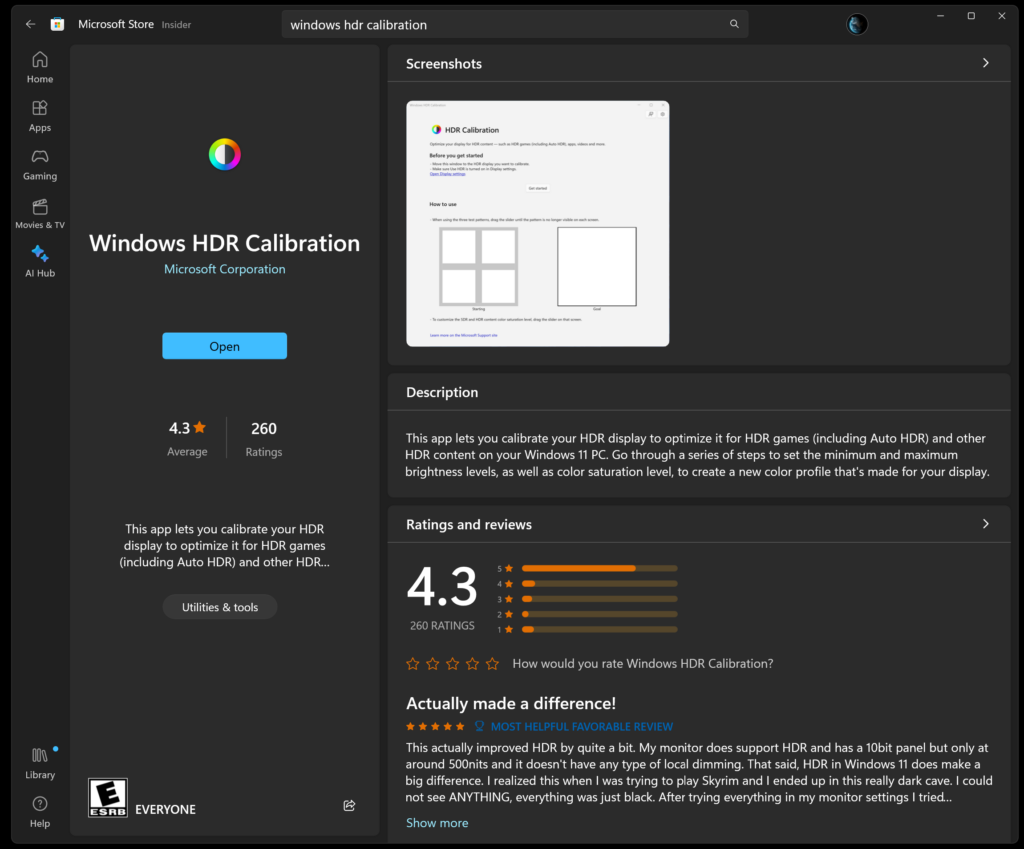
NVIDIA Control Panel Digital Vibrance & Color Adjustment
Step 5 (LAST STEP): Adjust Color & Color Saturation in NVIDIA Control Panel for ASUS PG42UQ OLED V40 Firmware
- Use the instructions on the following page to navigate the NVIDIA Control Panel for the best HDR settings for PG42UQ.
- Replace the values on the linked page with the values BELOW.
- The values below are broken up by NVIDIA Driver Versions. Make sure you use values that correspond to your NVIDIA Driver Version. (Sorry Team Red, hope to have settings in the future)
- The color correction values below are for Firmware V40 ONLY.
- IMPORTANT: If you plan to frequently switch between SDR and HDR, I recommend using the Recommended Vibrance setting or lower. This will prevent your SDR content from being oversaturated.
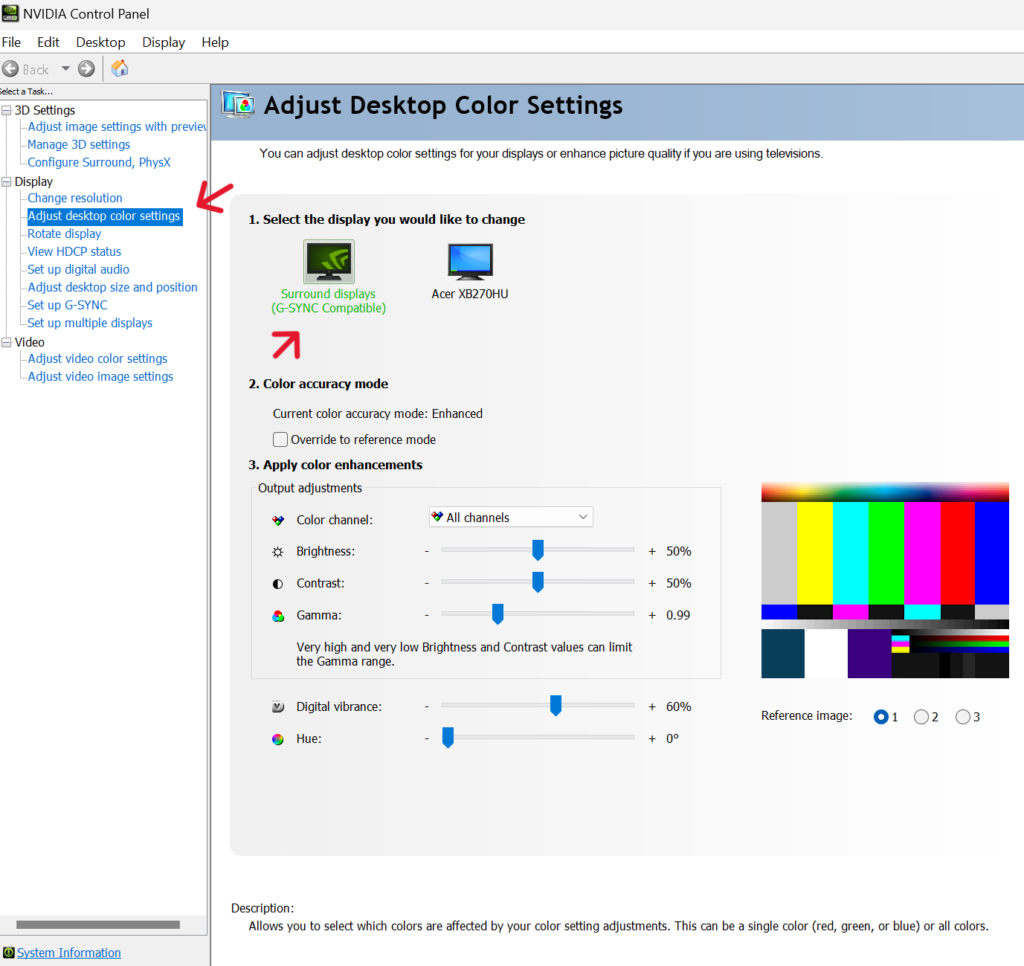
NVIDIA Control Panel Adjustment Values for PG42UQ V40
READ ABOUT: ASUS ROG Swift PG34WCDM – Specs & Release Date, Revealing ASUS ROG Swift PG34WCDM – Buyers Review
Receive notifications for updates to this guide and PC monitor related content. By adding your email to our list, you are:
- Helping us keep this guide updated
- Supporting the creation new guides in the future
- Helping us obtain and test new products from manufacturers.
- We DO NOT SHARE your email with any 3rd parties.
We thank you for showing your support for the PG42UQ HDR Settings Guide and our site!
NVIDIA Game Driver Version 576.80 (Current – 6/17/2025) – NVCP Settings
- Step 1 Digital Vibrance
- HDR 62% – 71% (Recommended: 66% HDR)
- SDR 50% – 52% (Recommended: 50% SDR)
- Step 2 Red Channel
- Brightness = 47%
- Contrast = 50%
- Gamma = 1.00
- Step 3 Green Channel
- Brightness = 47%
- Contrast = 50%
- Gamma = 0.99
- Step 4 Blue Channel
- Brightness = 55%
- Contrast = 50%
- Gamma = 1.06
NVIDIA Game Driver Version 576.40
- Step 1 Digital Vibrance
- HDR 62% – 71% (Recommended: 66% HDR)
- SDR 50% – 52% (Recommended: 50% SDR)
- Step 2 Red Channel
- Brightness = 45%
- Contrast = 50%
- Gamma = .99
- Step 3 Green Channel
- Brightness = 47%
- Contrast = 47%
- Gamma = 0.98
- Step 4 Blue Channe
- Brightness = 57%
- Contrast = 50%
- Gamma = 1.00
NVIDIA Game Driver Version 576.02 (4/16/2025)
- Step 1 Digital Vibrance
- HDR 62% – 71% (Recommended: 66% HDR)
- SDR 50% – 52% (Recommended: 50% SDR)
- Step 2 Red Channel
- Brightness = 45%
- Contrast = 50%
- Gamma = .99
- Step 3 Green Channel
- Brightness = 47%
- Contrast = 47%
- Gamma = 0.98
- Step 4 Blue Channe
- Brightness = 57%
- Contrast = 50%
- Gamma = 1.00
NVIDIA Game Driver Version 572.70 – 3/5/2025
- Step 1 Digital Vibrance
- HDR 58% – 65% (Recommended: 62% HDR)
- SDR 50% – 52% (Recommended: 50% SDR)
- Step 2 Red Channel
- Brightness = 45%
- Contrast = 50%
- Gamma = .99
- Step 3 Green Channel
- Brightness = 47%
- Contrast = 47%
- Gamma = 0.98
- Step 4 Blue Channe
- Brightness = 57%
- Contrast = 50%
- Gamma = 1.00
NVIDIA Game Driver Version 572.16 & 566.36
- Step 1 Digital Vibrance
- HDR 59% – 66% (Recommended: 63% HDR)
- SDR 50% – 52% (Recommended: 50% SDR)
- Step 2 Red Channel
- Brightness = 45%
- Contrast = 50%
- Gamma = .99
- Step 3 Green Channel
- Brightness = 47%
- Contrast = 47%
- Gamma = 0.98
- Step 4 Blue Channel
- Brightness = 57%
- Contrast = 50%
- Gamma = 1.00
NVIDIA Game Driver Version 561.09 – 566.14
- Step 1 Digital Vibrance
- HDR 59% – 67% (Recommended: 64% HDR)
- SDR 50% – 52% (Recommended: 50% SDR)
- Step 2 Red Channel
- Brightness = 47%
- Contrast = 47%
- Gamma = 1.00
- Step 3 Green Channel
- Brightness = 50%
- Contrast = 50%
- Gamma = 0.98
- Step 4 Blue Channel
- Brightness = 55%
- Contrast = 52%
- Gamma = 1.05
NVIDIA Game Driver Version 560.81
- Step 1 Digital Vibrance
- HDR 57% – 68% (Recommended: 64% HDR)
- SDR 50% – 52% (Recommended: 50% SDR)
- Step 2 Red Channel
- Brightness = 47%
- Contrast = 47%
- Gamma = 1.00
- Step 3 Green Channel
- Brightness = 50%
- Contrast = 50%
- Gamma = 0.98
- Step 4 Blue Channel
- Brightness = 55%
- Contrast = 52%
- Gamma = 1.05
NVIDIA Game Driver Version 556.12
- Step 1 Digital Vibrance
- HDR 63% – 70% (Recommended: 67% HDR)
- SDR 50% – 53% (Recommended: 50% SDR)
- Step 2 Red Channel
- Brightness = 50%
- Contrast = 50%
- Gamma = 0.98
- Step 3 Green Channel
- Brightness = 50%
- Contrast = 50%
- Gamma = 0.98
- Step 4 Blue Channel
- Brightness = 55%
- Contrast = 50%
- Gamma = 1.05
NVIDIA Game Driver Version 555.99
- Step 1 Digital Vibrance
- HDR 63% – 70% (Recommended: 67% HDR)
- SDR 50% – 53% (Recommended: 50% SDR)
- Step 2 Red Channel
- Brightness = 50%
- Contrast = 50%
- Gamma = 0.99
- Step 3 Green Channel
- Brightness = 50%
- Contrast = 50%
- Gamma = 1.00
- Step 4 Blue Channel
- Brightness = 55%
- Contrast = 50%
- Gamma = 1.03
NVIDIA Game Driver Version 555.85
Note** – If the ‘Display Settings’ in NVIDIA Control Panel are missing, you might need to rollback your driver to version 552.44. Use the 552.44 settings below instead of the 555.85 settings. You can try a ‘clean installation’ with the new driver via ‘custom install’. While this resolved the issue in our testing, the error came back after restarting the PC. So we recommend rolling back your driver to version 552.44 and skip version 555.85 altogether.
- Step 1 Digital Vibrance
- HDR 60% – 70% (Recommended: 67% HDR)
- SDR 50% – 53% (Recommended: 51% SDR)
- Step 2 Red Channel
- Brightness = 50%
- Contrast = 45%
- Gamma = 0.99
- Step 3 Green Channel
- Brightness = 50%
- Contrast = 50%
- Gamma = 1.00
- Step 4 Blue Channel
- Brightness = 57%
- Contrast = 50%
- Gamma = 1.02 – 1.03
NVIDIA Game Driver Version 552.22 & 552.44
- Step 1 Digital Vibrance
- HDR 57% – 64% (Recommended: 60% HDR)
- SDR 50% – 53% (Recommended: 50% SDR)
- Step 2 Red Channel
- Brightness = 50%
- Contrast = 50%
- Gamma = 0.98
- Step 3 Green Channel
- Brightness = 50%
- Contrast = 50%
- Gamma = 1.00
- Step 4 Blue Channel
- Brightness = 57%
- Contrast = 50%
- Gamma = 1.05
NVIDIA Game Driver Version 551.86 & 551.76 – NVCP Settings
- Step 1 Digital Vibrance
- HDR 60% – 70% (Recommended: 63% HDR)
- SDR 50% – 53% (Recommended: 51% SDR)
- Step 2 Red Channel
- Brightness = 50%
- Contrast = 50%
- Gamma = 0.98
- Step 3 Green Channel
- Brightness = 50%
- Contrast = 50%
- Gamma = 1.00
- Step 4 Blue Channel
- Brightness = 57%
- Contrast = 50%
- Gamma = 1.03
NVIDIA Game Driver Version 551.52 & 551.61 – NVCP Settings
- Step 1 Digital Vibrance
- HDR 60% – 68% (Recommended: 63% HDR)
- SDR 50% – 55% (Recommended: 51% SDR)
- Step 2 Red Channel
- Brightness = 47%
- Contrast = 50%
- Gamma = 0.99
- Step 3 Green Channel
- Brightness = 50%
- Contrast = 50%
- Gamma = 1.00
- Step 4 Blue Channel
- Brightness = 57%
- Contrast = 50%
- Gamma = 1.04
NVIDIA Game Driver Version 551.23 (01/24/2024) – NVCP Settings
- Step 1 Digital Vibrance
- HDR 61% – 71% (Recommended: 65% HDR)
- SDR 50% – 55% (Recommended: 51% SDR)
- Step 2 Red Channel
- Brightness = 47%
- Contrast = 50%
- Gamma = 0.99
- Step 3 Green Channel
- Brightness = 50%
- Contrast = 50%
- Gamma = 1.00
- Step 4 Blue Channel
- Brightness = 57%
- Contrast = 50%
- Gamma = 1.04
NVIDIA Game Driver Version 546.65 (01/17/2024) – NVCP Settings
- Step 1 Digital Vibrance
- HDR 63% – 73% (Recommended: 69% HDR)
- SDR 50% – 58% (Recommended: 52% SDR)
- Step 2 Red Channel
- Brightness = 47%
- Contrast = 50%
- Gamma = 0.99
- Step 3 Green Channel
- Brightness = 50%
- Contrast = 50%
- Gamma = 1.00
- Step 4 Blue Channel
- Brightness = 57%
- Contrast = 50%
- Gamma = 1.04
NVIDIA Game Driver Version 546.33 (12/12/2023) – NVCP Settings
- Step 1 Digital Vibrance
- HDR 64% – 76% (Recommended: 71% HDR)
- SDR 50% – 58% (Recommended: 54% SDR)
- Step 2 Red Channel
- Brightness = 47%
- Contrast = 50%
- Gamma = 0.99
- Step 3 Green Channel
- Brightness = 50%
- Contrast = 50%
- Gamma = 1.00
- Step 4 Blue Channel
- Brightness = 57%
- Contrast = 50%
- Gamma = 1.02
NVIDIA Game Driver Version 546.29
- Step 1 Digital Vibrance
- HDR 64% – 76% (Recommended: 71% HDR)
- SDR 50% – 58% (Recommended: 54% SDR)
- Step 2 Red Channel
- Brightness = 47%
- Contrast = 50%
- Gamma = 0.99
- Step 3 Green Channel
- Brightness = 50%
- Contrast = 50%
- Gamma = 1.00
- Step 4 Blue Channel
- Brightness = 57%
- Contrast = 50%
- Gamma = 1.02
NVIDIA Game Driver Version 546.17
- Step 1 Digital Vibrance
- HDR 70% – 80% (Recommended: 76% HDR)
- SDR 54% – 61% (Recommended: 58% SDR)
- Step 2 Red Channel
- Brightness = 47%
- Contrast = 50%
- Gamma = 0.99
- Step 3 Green Channel
- Brightness = 50%
- Contrast = 50%
- Gamma = 1.00
- Step 4 Blue Channel
- Brightness = 57%
- Contrast = 50%
- Gamma = 1.02
NVIDIA Game Driver Version 546.01
- Step 1 Digital Vibrance
- HDR 66% – 73% (Recommended: 69% HDR)
- SDR 52% – 59% (Recommended: 56% SDR)
- Step 2 Red Channel
- Brightness = 47%
- Contrast = 50%
- Gamma = 0.99
- Step 3 Green Channel
- Brightness = 50%
- Contrast = 50%
- Gamma = 1.00
- Step 4 Blue Channel
- Brightness = 57%
- Contrast = 50%
- Gamma = 1.02
NVIDIA Game Driver Version 545.92
- Step 1 Digital Vibrance
- HDR 71% – 82% (Recommended: 76% HDR)
- SDR 50% – 57% (Recommended: 55% SDR)
- Step 2 Red Channel
- Brightness = 47%
- Contrast = 50%
- Gamma = 0.97
- Step 3 Green Channel
- Brightness = 50%
- Contrast = 50%
- Gamma = 1.00
- Step 4 Blue Channel
- Brightness = 57%
- Contrast = 50%
- Gamma = 1.03
NVIDIA Game Driver Version 545.84
- Step 1 Digital Vibrance
- HDR 75% – 84% (Recommended: 79% HDR)
- SDR 50% – 57% (Recommended: 55% SDR)
- Step 2 Red Channel
- Brightness = 47%
- Contrast = 50%
- Gamma = 0.97
- Step 3 Green Channel
- Brightness = 50%
- Contrast = 50%
- Gamma = 1.00
- Step 4 Blue Channel
- Brightness = 55%
- Contrast = 50%
- Gamma = 1.03
NVIDIA Game Driver Version 537.58
- Step 1 Digital Vibrance
- 69% – 77% (Recommended: 71%)
- Step 2 Red Channel
- Brightness = 47%
- Contrast = 50%
- Gamma = 0.96
- Step 3 Green Channel
- Brightness = 50%
- Contrast = 50%
- Gamma = 1.00
- Step 4 Blue Channel
- Brightness = 52%
- Contrast = 50%
- Gamma = 1.03
NVIDIA Game Driver Version 537.42 & 537.34
- Step 1 Digital Vibrance
- 69% – 77%. (Recommended: 71%)
- Step 2 Red Channel
- Brightness = 47%
- Contrast = 50%
- Gamma = 0.96
- Step 3 Green Channel
- Brightness = 50%
- Contrast = 50%
- Gamma = 1.00
- Step 4 Blue Channel
- Brightness = 55%
- Contrast = 50%
- Gamma = 1.03
NVIDIA Game Driver Version 537.13 – NVCP Settings
- Step 1 Digital Vibrance
- 71% – 79%. (Recommended: 76%)
- Step 2 Red Channel
- Brightness = 47%
- Contrast = 50%
- Gamma = 0.98
- Step 3 Green Channel
- Brightness = 50%
- Contrast = 50%
- Gamma = 1.00
- Step 4 Blue Channel
- Brightness = 55%
- Contrast = 50%
- Gamma = 1.03
NVIDIA Game Driver Version 536.99 – NVCP Settings
- Step 1 Digital Vibrance
- 62% – 73%. (Recommended: 69%)
- Step 2 Red Channel
- Brightness = 47%
- Contrast = 50%
- Gamma = 0.98
- Step 3 Green Channel
- Brightness = 50%
- Contrast = 50%
- Gamma = 1.00
- Step 4 Blue Channel
- Brightness = 52%
- Contrast = 50%
- Gamma = 1.03
NVIDIA Game Driver Version 536.67 – NVCP Settings
- Step 1 Digital Vibrance
- 54% – 64%. (Recommended: 59%)
- Step 2 Red Channel
- Brightness = 47%
- Contrast = 50%
- Gamma = 0.99
- Step 3 Green Channel
- Brightness = 50%
- Contrast = 50%
- Gamma = 1.00
- Step 4 Blue Channel
- Brightness = 50%
- Contrast = 50%
- Gamma = 1.02
NVIDIA Game Driver Version 536.40 – NVCP Settings
- Step 1 Digital Vibrance
- 62% – 69%. (Recommended: 65%)
- Step 2 Red Channel
- Brightness = 47%
- Contrast = 50%
- Gamma = 0.97
- Step 3” Green Channel
- Brightness = 50%
- Contrast = 50%
- Gamma = 1.00
- Step 4 Blue Channel
- Brightness = 52%
- Contrast = 50%
- Gamma = 1.02

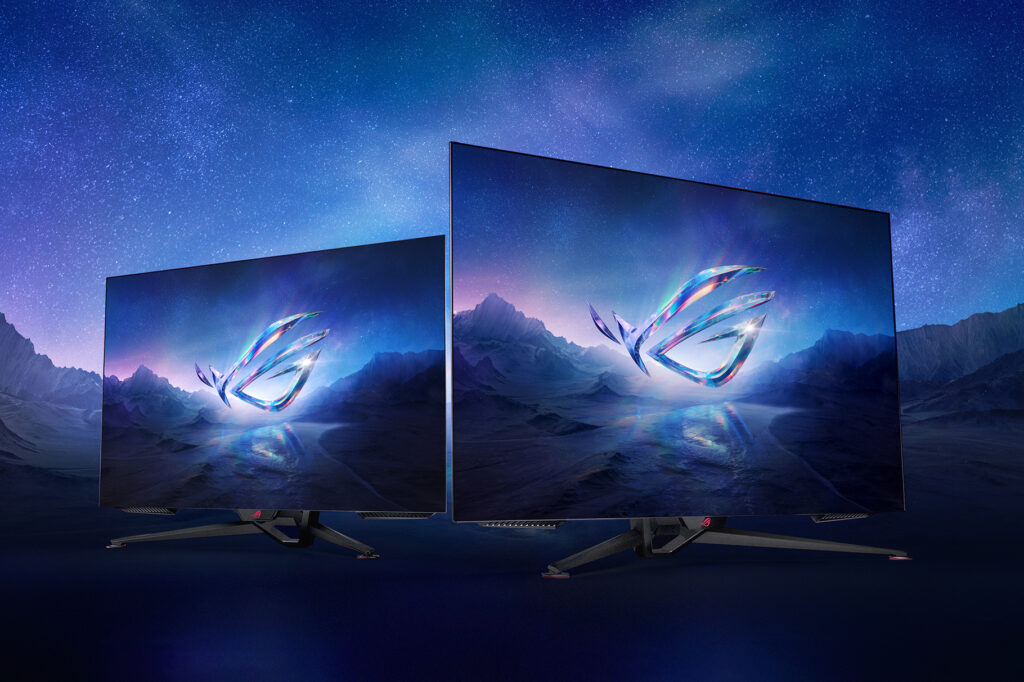



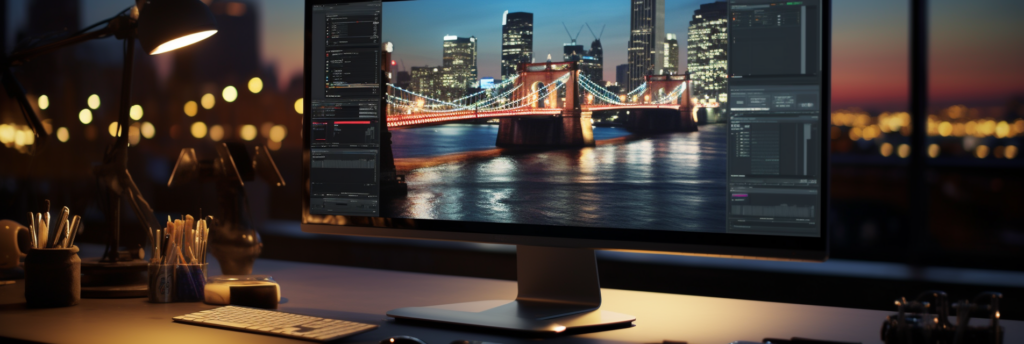
I knew it that I can find the latest update here!
Thanks for your effort.
I’m gonna try V040 firmware.
BTW, I have a question about installing the PG42UQ display driver.
If I enable Nvidia surround, do I need to install the driver again? Or I just install driver for each monitor seperately?
Glad you thought of WiredColony :D. So to answer your question, you don’t need to reinstall the display driver. It should already be using it before Nvidia Surround. Also, the saturation appears to have changed over a bit of time. I think it is back to V037 levels of saturation but, no black screens. Nonetheless, definitely worth using V40.
I purchased this monitor a couple of weeks ago. Its the first TV/Monitor I’ve owned with OLED and HDR. I was a bit reluctant to get OLED as i’ve heard a lot about burn-in issues. Still, I thought it was time to give it a shot and I’ve got to say its a beast. It’s not only made my games look a million times better but also perform better due to the 120Hz. I’m running it on an i7 13700K and RTX 4080 system.
My monitor actually has version 042 of the firmware on it but i can’t find that firmware on the ASUS site so not sure what the deal it there.
I didn’t really use the monitor with its default settings so its hard to say what the difference is between default and these settings on this guide. It’s an excellent guide and would say its the best out there as I checked a few others out before this one.
Also, want to say thanks to Raj for helping me get registered on this site ;o)
Hi @dooky1973, thanks for sharing this post. I am surprised to learn there is a V042 firmware update. My guess is, the newer version coorelates to different hardware. Perhaps they have changed some things up with your “newer” pg42uq.
I am curious, have you tried out HDR in both games and regular Windows use? If so, how did it look without the settings provided here? The major issue with the monitor and the reason why this particular webpage exists is because of issues with HDR. Basically, without these settings, HDR is washed out and tints everything with a beige-ish overlay. It is really bad.
If you could test out HDR, on default Nvidia Control Panel settings, I would love to hear about how it looks. You could even post pics here for anyone who comes to this page. I might even create a seperate post if there is a big difference.
There easiest way to go back to defaults is to check the checkbox “Override to reference mode” in NVIDIA Control Panel. That way you don’t have to redo your settings. If you scroll up to the last picture of this post, you will see the window where this checkbox is.
Also we thank you for bringing the registering issue to our attention. The issue has been resolved. Many thanks to you!
I can say I totally agree with what you say about default HDR settings. It definitely looks washed out and dull. I also followed a guide for SDR settings before I started using HDR, as again, the default SDR settings are not the best.
In my opinion, it’s rare to get a TV/Monitor that is perfect with factory default settings and this monitor is no exception. But, with some help from people like yourself, things can be much improved. I am really pleased with the picture on mine and is a vast improvement on what I had with my previous screen which was a Smart TV (Panasonic TX-40DX600B).
I tried to capture some screens from my PC and even photos off my phone but you just can’t see the difference as well as you can by physically seeing it.
Interesting…I guess they didn’t fix the HDR issues. The washing out of HDR is actually not very common from my experience. I have LG C1 & C2 and the HDR works right out of the box; no adjustments. I was hoping they fixed it since you had a new firmware version (v42). Oh well, I think this monitor is “too old” for them to fix it. For the size however, it is still the best OLED in the market with DisplayPorts. By the way, thanks for all your input.
Hi teedog, just wanted to say thanks for keeping up with these HDR settings updates with the new drivers. I have this page bookmarked and come here every time a new driver rolls out to see if I need to tweak the digital vibrance/rgb. Imo Asus should pay you a percentage for every unit of this monitor sold!
Hey Carlo, I appreciate the praise. You are very welcome! If you are not already on the PG42UQ email list, you can join that and you will get updates as soon as I update that page. You can find the link right above the latest settings. (I just moved it there…it was too far above the page for any one to see before. You are absolutely right about ASUS, I am sure I saved some returns. At the very least you, I and a few others kept our PG42UQ. 😄